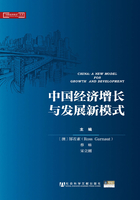
六 政策建议
中国的市场经济改革是不完全的。这种状况,特别是要素市场的普遍扭曲,带来了中国经济增长的成功,但也引发了诸如结构性风险在内的很多问题。近期,要素市场的变化,包括劳动力短缺和工资快速上涨,已经减慢了经济增速,推动了经济再平衡,这二者都是经济发展“新常态”的关键特征。
这一再平衡趋势不应与一些周期性变化相混淆。例如,尽管在总体趋势上投资在GDP中的份额会降低而消费份额会上升,但是2013年初的情形却与此相反。由于基础设施支出是近期唯一不确定的因素,政府稳增长的政策不可避免地会引发增长速度的反弹。不过,政府增长目标已经低多了。同时,消费特别是高端消费支出,也受到了政府打击腐败活动的负向影响。
这些暂时性的干扰不会扭转经济再平衡的总体趋势,除非政府会再次推动投资导向型增长模式。尽管这样的政策不大可能发生,但风险却仍然存在。新一届政府致力于加速城镇化进程,这将会推动进一步的投资。同时,地方政府已经再次计划推出大规模的投资项目。不过,地方投资项目将主要受制于其融资能力。而北京方面对地方乃至中央投资项目予以适当控制对经济再平衡过程的延续将至关重要。
但是,仅仅依靠再平衡过程自身是不够的,还需要进一步的政策改革以实现向新常态转型以及避免中等收入陷阱。前国家主席胡锦涛认为,下一阶段的改革应围绕重塑政府与市场的关系这一中心主题(胡锦涛,2012)。我们认为,这可能包括如下三个领域的重要政策改革。
第一,如果说中国在改革前属于非市场经济,在改革最初三十年属于半市场经济,那么现在就是消除现存扭曲,特别是要素市场扭曲,从而转向全面市场经济的时机。
第二,中国需要建立一套与新兴的市场经济更加适应的宏观经济政策体系,包括可问责的财政预算体系和专业化的货币政策制定机制。中国的宏观经济政策框架在本质上仍保持着行政性质。例如,和四万亿元刺激政策相关的很多问题与扩张性政策的初衷并不符合,而是与投资项目由银行、国企以及地方政府支持和实施相关。
第三,政府角色需要从通过调配资源直接支持生产和投资,转变为通过支持发展软硬件基础设施促进创新和产业升级。这包括加大支持全国教育和科研体系,以及促进知识产权的保护。在可见的未来,一项关键考验就是提升数量巨大的农民工的技能,他们中的绝大部分只受过不足7年的教育。为农民工们设置培训项目,以使他们在当前的雇主因快速上涨的成本而被淘汰后,能转移到新的行业,这是非常重要的。
参考文献
Acemoglu, Daron&Robsin, James A. , 2012, Why Nations fail: The Origins of Power, Prosperity and Poverty, Crown Publishers, New York.
Cai, Fang(ed.), 2007, Reports on China's Population and Labor, No.8: The Lewisian Turning Point and Policy Challenges(in Chinese), Social Sciences Academic Press, Beijing.
Cai, Fang&Lu, Yang, 2012, “At What Rate can Chinese Economy Grow in the Next 10 Years? ”,(in Chinese)in Jiagui Chen et al.(eds.), Chinese Economy Blue Cover Book 2012, Social Sciences Academic Press.
Cai, Fang&Wang, Dewen, 2006, “Employment Growth, Labor Scarcity and the Nature of China's Trade Expansion”, in Ross Garnaut&Ligang Song(eds.), The Turning Point in China's Economic Development, Asia Pacific Press, Canberra.
Cai, Fang&Wang, Meiyan, 2008, “A Counterfactual Analysis on Unlimited Surplus Labor in Rural China”, China&World Economy, Vol.16, No.1, pp. 51-65.
Eichengreen, Barry, Park, Donghyun&Shin, Kwanho, 2011, “When Fast Growing Economies Slow Down: International Evidence and Implications for China”, NBER Working Paper 16919.
Lu, Feng, 2011, “Employment Expansion and Wage Growth(2001-2010)”, China Macroeconomic Research Center, Peking University, Beijing, 12 June. The New Normal of Chinese Development 53.
Garnaut, Ross&Huang, Yiping, 2006, “Continued Rapid Growth and the Turning Point in China's Economic Development”, in Ross Garnaut&Ligang Song(eds), The Turning Point in China's Economic Development, Asia Pacific Press, Canberra.
Hu, Jintao, 2012, “Firmly March on the Path of Socialism with Chinese Characteristics and Strive to Complete the Building of a Moderately Prosperous Society in all Respects”, Political Report Delivered at the 18th National Party Congress, 8 November 8, Beijing.
Huang, Yiping, 2004, “A Labor Shortage in China”, Wall Street Journal, A7, 6 -8 August.
“Dissecting the China Puzzle: Asymmetric Liberalization and Cost Distortion”, Asia Economic Policy Review, 2010, Vol.5, No.2, pp.281-95.
“The ‘New Normal' of Chinese Growth”, East Asia Forum, 14 October, 2012, http://www.eastasiaforum.org/2012/10/14/the-new-normal-of-chinese-growth/.
Huang, Yiping&Cai, Fang(eds.), 2010, “Debating China's Lewis Turning Point”, China Economic Journal, Vol.3, No.2.
Huang, Yiping&Kunyu, Tao, 2010, “Factor Market Distortion and the Current Account Surplus in China”, Asian Economic Papers, Vol.9, No.3, pp.1-36.
Huang, Yiping&Jiang, Tingsong, 2010, “What Does the Lewis Turning Point Mean for China? A Computable General Equilibrium Analysis”, China Economic Journal, Vol.3, No.2, pp.191-208.
Huang, Yiping&Wang, Bijun, 2010, “Cost Distortions and Structural Imbalances in China”, China and World Economy, Vol.18, No.4, pp.1-17.
Huang, Yiping, Chang, Jian&Yang, Lingxiu, 2011, China: Beyond the Miracle—China's Next Transition, September, Barclays, Hong Kong.
“China: Beyond the Miracle—Great Wave of Consumption Upgrading”, January, 2012, Barclays, Hong Kong.
“Recovery of Consumption and Rebalance of the Economy in China”, Asian Economic Papers, 2013 Vol.12, No.1, pp.47-67.
Krugman, Paul, 1994, “The Myth of Asia's Miracle”, Foreign Affairs, November/December, Vol.73, No.6, pp.62-78.
Lardy, Nicholas R. , 2012, Sustaining China's Economic Growth after the Global Financial Crisis, Peterson Institute of International Economics, Washington DC.
Li, David&Xu, Sean, 2012, “The Rebalancing of the Chinese Economy”, CCER-NBER conference on the Chinese Economy, Peking University, 25-26 June, Beijing.
Lin, Justin, 2011, Demystifying the Chinese Economy, Cambridge University Press.
Lin, Justin, 2012, The Quest for Prosperity: How Developing Economies Can Take off?Princeton University Press.
Lin, Justin, Cai, Fang&Li, Zhou, 1995, The China Miracle: Development Strategy and Economic Reform, The Chinese University of Hong Kong Press.
Naughton, Barry, 1995, Growing Out of the Plan: Chinese Economic Reform, 1978 -1993, Cambridge University Press.
Perkins, Dwight&Rawski, Thomas G. , 2008, “Predicting the Chinese Economy by 2025”, in Loren Brandt&Thomas Rawski(eds.), China's Great Economic Transformation, Cambridge University Press.
Pettis, Michael, 2013, Great Rebalancing: Trade, Conflict, and Perilous Road Ahead for the World Economy, Princeton University Press.
Sachs, Jeffrey D.&Woo, Wing Thye, 2000, “Understanding China's Economic Performance”, Journal of Policy Reform, Vol.4, No.1, pp.1-50.
Tian, Zhu&Jun, Zhang, 2012, “Is China's Consumption Rate too Low? ”, Finance Times Chinese Website(http://www.ftchinese.com/story/001048246/?print=y).
Wen, Jiabao, 2006, Government Work Report, Delivered at the National People's Congress meeting, 5 March, Beijing.
World Bank&Development Research Center of the State Council(WB&DRC), 2012, China: 2030—Building a Modern, Harmonious, and Creative High-Income Society, March, Washington D. C.&Beijing.
Yu, Yongding, 2009, “Chinese Policy Responses to the Global Financial Crisis”, Richard Snape Lecture, 25 November 2009, Productivity Commission, Melbourne, Australia.
Zhuang, Juzhong, 2013, Vandenberg, Paul&Huang, Yiping, “Growth Beyond Low-Cost Advantages: Can the People's Republic of China Avoid the Middle-Income Trap? ”, October, Asian Development Bank&Peking University, Manila&Beijing.
(彭旭 苟琴 译)